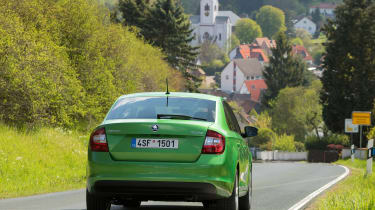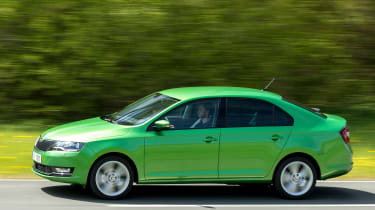New Skoda Rapid 2017 facelift review
A series of light updates has done little to improve the Skoda Rapid, as it's still beaten by its more modern hatchback rivals

A light facelift hasn’t done much to change the Skoda Rapid’s middle-of-the-road standing. It’s spacious and dependable, yet at nearly £20,000, this top-spec version certainly doesn’t live up to the Rapid’s value image. The 1.6-litre TDI diesel engine isn’t that refined, and the new 1.0-litre petrols nearly match it for economy. So most buyers will still be better off with a more modern hatch, such as the Vauxhall Astra – or Skoda’s own Octavia.
The regular Skoda Rapid isn’t exactly a big seller in Britain, because its Spaceback brother accounts for four out of five sales in the range. This diesel version is an even less common option in the line-up – it’s mostly bought by fleet customers – and even if you total up all the Rapid sales in this country, there aren’t that many of them.
It’s easy to see the reasons behind this when you get in the Rapid hatchback, even after its latest facelift. A few changes to the lights and bumpers, plus some new interior trim, have tightened up the looks, but the car still feels old-fashioned. Hard plastic trim means it feels reasonably well built, but not very luxurious; even Skoda’s Citigo city car beats it for perceived quality.
Used - available now

2020 Suzuki
SX4 S-Cross
46,548 milesManualPetrol1.4L
Cash £11,997
2020 BMW
X2
44,368 milesAutomaticPetrol2.0L
Cash £14,997
2021 SEAT
Ibiza
18,736 milesManualPetrol1.0L
Cash £14,897
2023 Land Rover
Discovery
13,183 milesAutomaticDiesel3.0L
Cash £57,500Mid-life tweaks include the addition of a 6.5-inch touchscreen in the centre of the facia but this still feels like a very basic interior. Even the display itself has a low resolution and it feels slow to respond to inputs – precisely the sort of unit that’s been left behind by the technology of modern smartphones.
Of course, the Rapid is meant to be a value-orientated budget car, but unlike the Citigo, it just doesn’t manage to live up to that billing. Indeed, at £19,855, this model is easily within sight of its Octavia bigger brother, or even a hatch like the Vauxhall Astra. Both of those alternatives feel like properly modern family cars, too.
The 1.6-litre diesel engine in this Rapid is noisy and coarse, and although it’s the most powerful version you can buy, it doesn’t even feel as lively as the new 1.0-litre petrol model. The diesel’s low-down torque is useful for the motorway, admittedly, and economy of 67.3mpg means it’s the best choice for a long commute – but at any speed you’ll notice the unpleasant diesel rattle from up front. It doesn’t help that the more agreeable petrol motor is considerably cheaper, too.
The Rapid is set up for comfort, so keen drivers will be put off by the body roll and vague steering, but most buyers will be happy to hear that the facelifted Skoda still rides smoothly, and that the light controls mean it’s easy to drive. The five-speed manual gearbox has a light, smooth shift as well.
However, the overall focus is very much on steady comfort, so don’t expect anything approaching entertainment. The driving dynamics match the looks and the interior – which is to say that they’re serviceable but fail to stand out in a crowded market.
• Skoda Rapid Spaceback facelift review
While most buyers prefer the Spaceback version, the Rapid actually has much more boot space, with an impressive 550 litres in the back. There’s plenty of rear legroom, too, so the Rapid’s best point has to be practicality.
Helped by a long ‘notchback’ that’s not dissimilar to the Octavia’s, the Rapid’s boot is wide, long and deep, and will be perfect for big suitcases and holiday gear, while the plentiful space in the rear seats means the car is good at carrying passengers as well.
If you choose carefully, and stick to the cheaper trim levels, the Rapid range does have the potential to offer lots of space and reasonable fuel economy.
But it’s an SE L version of the diesel that we’re testing here, and this car’s biggest problem is that its relatively weak residuals mean it’s not even that cheap on a finance deal. Haggle hard and the (vastly superior) Octavia could even cost you less per month.










